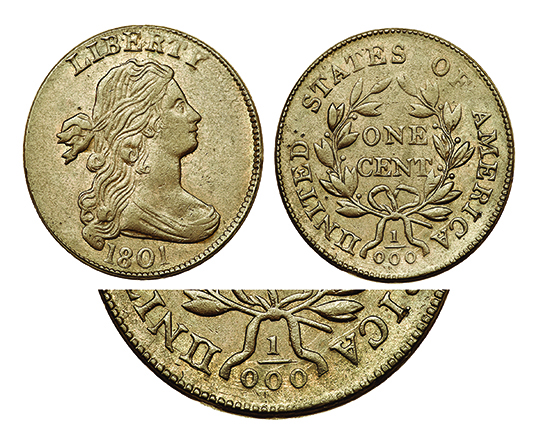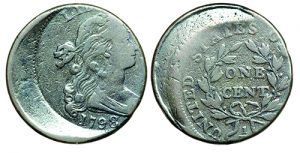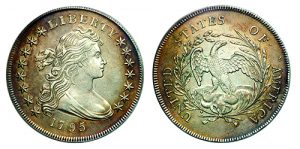
By R.W. Julian
There are those today who buy gold and silver bullion as an investment even though the outlook is sometimes volatile. Rare collector coins, on the other hand, are another matter.
The demand for early American coins, especially the lowly cent, has driven up prices far exceeding inflation. As but one example out of many, in 1990, the 1804 Draped Bust cent in Extremely Fine condition was worth about $4,500, while in January 2019, the estimated cost to the collector is $17,000.
Appeal of Early Copper Coinage
Those who specialize in the early copper coinage of the United States are also well aware of the enjoyment that comes from studying and collecting the famous Draped Bust cents, first struck in the fall of 1796. For more than 150 years, collectors have specialized in these coins and the interesting die varieties that go with them.
The Draped Bust cents were among the first coins laid aside in the 1850s when coin collecting became a national hobby. It was this series of coins, perhaps more than any other, that encouraged interest in the early coinage of the United States.
The story begins at the Philadelphia Mint in the summer of 1795.
In early July 1795, Henry William DeSaussure became director of the Mint, replacing the first director, David Rittenhouse. The new director energetically set about his duties and one of the events that occurred during his few months in office was the introduction, at the beginning of October 1795, of the famous Draped Bust silver dollar.
Revisions to Liberty’s Design

What part DeSaussure played in the change of design is not known but was probably minimal, as such decisions were matters of government policy because of the criticism directed at the Mint in Congress and elsewhere. According to a later writer, famed artist Gilbert Stuart made sketches for a new bust of Liberty. Once the drawings were approved, they were sent off to John Eckstein, a Philadelphia artist who prepared plaster models to guide Mint Engraver Robert Scot in engraving the dies.
Scot soon executed the new dollar hubs and dies, but it was some time before all of the silver and copper denominations got the new obverse. Cutting the hubs, from which the working dies are made, is a tedious and careful business requiring considerable time.
Elias Boudinot replaced DeSaussure as director in late October 1795 and was also an energetic individual. One of his major problems, and one that had not been solved by his two predecessors, was a steady supply of copper for coinage. The Mint had run out of usable copper in May 1796, and there was none in sight.
Over the winter of 1795-1796, Boudinot had corresponded with the Governor & Company of Copper Miners in England, who had informed him that their product was of the highest quality and that he could depend on it. The director ordered several tons each of sheet copper and ready-made planchets, but it took some months to arrive. Planchets were cut directly from the sheet copper, which was made to a certain thickness.
Prepping Planchets
In the meantime, Boudinot also wrote Matthew Boulton, the famed English private coiner and copper manufacturer of Birmingham. Unfortunately, Boulton was quite busy with other contracts and put Boudinot off until a later time.
The Governor & Company copper was received in October 1796, but Boudinot was less than thrilled when he saw it. The sheet copper had to be scoured before it could be used, and the ready-made planchets were not much better; many of the latter also had to be cleaned by hand, thus losing any price advantage that might have been gained by using them.
Boudinot, because there was a strong demand from the public for cents and the Mint had been out of them for months, had little choice except to use the flawed Governor & Company copper. The approximately 350,000 ready-made planchets were sent to the coining rooms and were struck into Draped Bust cents during November and December 1796. This was the first coinage of the new design.
Minor varieties exist for the 1796 cent, mainly of interest to specialists in the field. The so-called “LIHERTY” obverse is actually the result of a die that was ground down to remove defects. Ordinary Draped Bust cents of 1796 have a book value of $1,000 in Fine-12, while even in Good-4 they are around $400. In the upper grades the 1796 cents of this design are worth several thousand dollars.
Demand for Copper Drives Interest
There was some hesitation about using the Governor & Company sheet copper (from which

the Mint cut planchets), but in February 1797, this too was sent to the coining rooms.
Demand was still reasonably heavy, and the 400,000 planchets obtained were all struck by about March 15. It is not certain if 1796 dies were used for this coinage.
With the last delivery of cents in March 1797, the Mint was once more out of copper, but only in a technical sense. There was a large quantity of clippings on hand from the sheet copper just used, but Boudinot ordered that this copper (called shruf) be sold to local metal workers. The Mint rolling mills, which flattened the ingots of metal, were in such poor shape that the director decided to keep them for use on the precious metals (silver and gold) only.
Boudinot once more appealed to Matthew Boulton but also asked a close relative in England (Samuel Bayard) to press Boulton for ready-made planchets. Bayard was an American official whose job was to settle outstanding financial problems between the United States and Great Britain. He also reluctantly ordered four more tons of planchets from Governor & Company.
Yellow Fever Impacts Mintage
The Mint was closed for the Yellow Fever epidemic in the early fall of 1797; several employees of the Mint, including Treasurer Nicholas Way, succumbed to the deadly disease. While the doors were locked, copper from both Boulton and Governor & Company arrived at the Philadelphia docks.
One pleasant custom of the time has not survived to the present. It was traditional to issue a liberal ration of rum to the laborers handling the heavy casks of planchets unloaded from the ships. Each cask weighed about 420 pounds, and the men certainly worked up a sweat in hauling them to the Mint. The government paid 9 cents to have each cask brought from the docks and carried inside the Mint.
The Boulton planchets proved ideal but the Governor & Company work was just as bad as before; the latter company would sell no more copper to the Philadelphia Mint. Boulton, on the other hand, would produce planchets for cents and half cents until 1838, thereby providing more than 40 years of service to American coinage.
The planchets, regardless of source, were quickly sent to the coining rooms when the Mint reopened for business in early November 1797. It is nearly certain that dies of 1797 were in use by this time and may, of course, have been employed as early as the preceding February and March.
‘Stemless’ State of 1797 Cents

There are several minor varieties for the 1797 cents. One that has attracted collector interest for more than a century is the “stemless” reverse. The stems at the bottom of the wreath were always punched in by hand and, for certain reverse dies, the engraver simply forgot them.
Coinage of cents was halted in mid-December 1797, with demand temporarily satisfied, but resumed about a month later. The last of the copper on hand, all from Governor & Company, was used in July 1798; by a stroke of luck, another shipment from Boulton was received just as the earlier copper was exhausted. The 10 tons of Boulton planchets (930,000 pieces) were a godsend, and the copper was sent immediately to the coining rooms.
Yellow Fever visited its wrath on Philadelphia again during the summer and fall of 1798, and the Mint was once more forced to close its doors, this time on August 17; it reopened in early November. At first, there was little demand for copper coinage but demand soon picked up as business revived; the presses churned out copper coins heavily in December.
The cents of 1798, which are far more common than the mintage reports indicate, are among the easiest of the 18th century coppers to obtain. The overdate of 1798 over 1797 (1798/7 in numismatic terminology) is scarcer than the average 1798 Draped Bust cent, but not by much. It is worth noting that the 1798/7 overdate is the first in the Draped Bust series.
Results of Copper Shortage
Cents of 1798 are more common than expected because the obverse dies for this year were used throughout most of 1799, a common practice in the early Mint to save money.
In some cases it is known that obverse dies were used as long as three years after their nominal date. A 1797 half cent obverse was still being used in the spring of 1800, for example.
The Mint again ran out of copper during the late winter of 1798-1799, and the sea lanes were now filled with letters from Boudinot to Boulton imploring him to send as many planchets as possible and soon. Boudinot’s entreaties were answered in July 1799 with the delivery of about 930,000 blanks. These were all struck by late August, when the Mint again closed for the Yellow Fever scourge.
Cents of 1799 do exist, and are quite rare, but it is far from certain just when they were struck. The estimate sometimes seen, 42,540 pieces, is known to be wrong and much too low, but the true number minted was probably under 100,000. Collectors have been searching for cents of this date for more than 150 years and the value, about $30,000 in VF-20, well reflects the strong demand from copper specialists. There are actually two major varieties: a regular date and an overdate, 1799/8, the latter being the scarcer of the two.
Plenty of Planchets for Copper Cents
The Mint reopened on November 6, 1799, after the epidemic had waned and immediately

began coining a fresh shipment of planchets from Boulton, some 1.9 million pieces. This was the largest delivery to date and, for once, the Mint did not have to worry about running out of copper in the immediate future. In fact, it was not until June 1800 that the last of these planchets was coined and distributed to the public.
By sheer coincidence, another delivery (950,000 pieces) was received from Boulton just as the last coins on hand were being paid out. It was perfect timing so far as Boudinot was concerned, and these were sent directly to the coining department. All were coined by the end of September 1800.
The cents of 1800 have the most interesting varieties of any of the Draped Bust design up to that year. There are several overdates, including 1800/1799 and 1800/179– (dies were normally made up without the last digit). The regular 1800 is worth about $1,000 in Very Fine-20, for example. Although overdates normally bring good money from specialists, in the case of 1800, the premium is not all that high as the overdates are relatively common.
Although the Mint was out of planchets at the end of September 1800, this time the institution was not so lucky in receiving a Boulton shipment in the nick of time. In fact, it was not until March 1801 that Boulton was able to notify Boudinot that a shipment was then being loaded for the long sea voyage to Philadelphia. It arrived in July, and the 1.9 million blanks were quickly unloaded and sent to the coining room.
Boulton also shipped 2.3 million planchets a few weeks later, and these were received in Philadelphia in October 1801. This meant that 4.2 million planchets had thus been received in 1801 and the long famine was now over; from 1801 until 1811, there would be no shortage of planchets for the cent.
Examining 1801 Error Cents
The regular 1801 cent is relatively common in dealers’ stocks, but there is one variety of the 1801, however, that has been avidly collected since the 1850s: the famous coin with three errors. The fraction is 1/000 instead of the correct 1/100, no stems, and “IINITED” instead of “UNITED.” In the last case, the letter “U” was first punched upside-down and then corrected, thus giving the appearance of “II” rather than “U.” Because the three-errors coin is not especially scarce, the value is little more than a regular piece: In Very Fine-20, it is worth less than $3,000, for example.
For 1802 and later coins, with one exception, the 1804, the values are roughly the same: Extremely Fine-40 about $1,000 and Fine-12 about $400. Actual prices, of course, vary from these estimates, depending upon the eye appeal and overall quality.
There are only a few outstanding varieties in the later years of the Draped Bust cent. The 1807/6 overdate, because there are two dies, is readily obtained. The larger of the two overdates is the more common and worth little more than a regular issue. The small overdate, however, is one of the rarer pieces in the series.

The 1804 cent has long been recognized as a major rarity, akin to the 1799. The dies began to break up at an early date and, because there was only the one pair, the date is very difficult to find in quality condition. In XF-40 the book value is $13,000, for example.
The 1806, with a mintage figure of 348,000, ought to be a rare coin, but in reality is only slightly scarcer than average for the period. The cent press broke down during the spring of that year and, because the Mint had accumulated a large number of coined cents for which there was no current demand, little haste was made in repairing the press. It was not, in fact, returned to service until January 1807. Because the dies of 1806 were still in good condition, they were used for some weeks into 1807.
It is believed that the cent dies of 1807 were likewise used for a time in the early part of 1808. In 1808, the new Classic Head design by John Reich was placed into service, and the Draped Bust cent would no longer be struck. It was the end of an interesting series of coins, well appreciated by present-day collectors and likely to remain so for generations to come.














